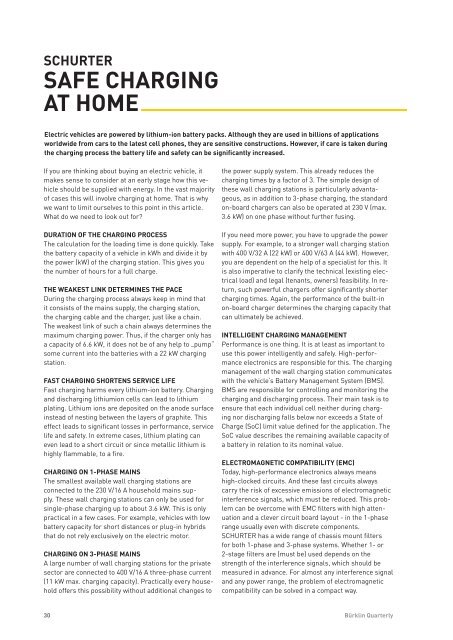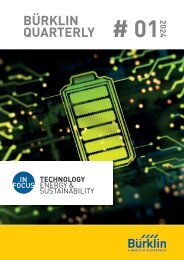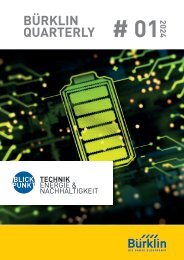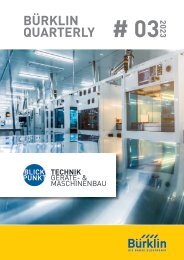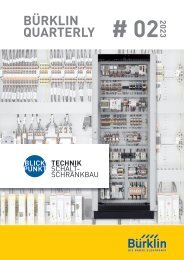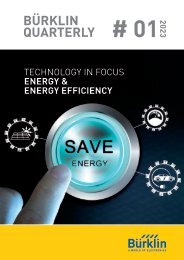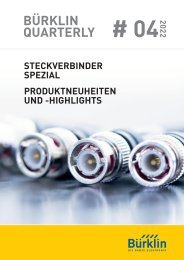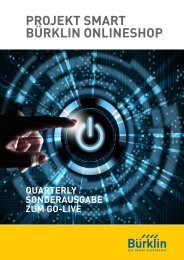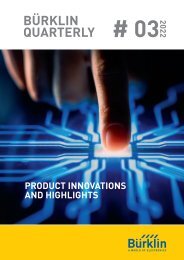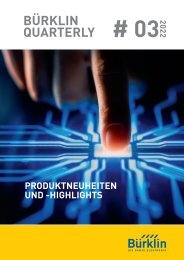Bürklin Elektronik Quarterly # 02/2022 Englisch
Bürklin Quarterly is a Bürklin Elektronik magazine published four times a year with profound information on services, products and manufacturers.
Bürklin Quarterly is a Bürklin Elektronik magazine published four times a year with profound information on services, products and manufacturers.
Erfolgreiche ePaper selbst erstellen
Machen Sie aus Ihren PDF Publikationen ein blätterbares Flipbook mit unserer einzigartigen Google optimierten e-Paper Software.
SCHURTER<br />
SAFE CHARGING<br />
AT HOME<br />
Electric vehicles are powered by lithium-ion battery packs. Although they are used in billions of applications<br />
worldwide from cars to the latest cell phones, they are sensitive constructions. However, if care is taken during<br />
the charging process the battery life and safety can be significantly increased.<br />
If you are thinking about buying an electric vehicle, it<br />
makes sense to consider at an early stage how this vehicle<br />
should be supplied with energy. In the vast majority<br />
of cases this will involve charging at home. That is why<br />
we want to limit ourselves to this point in this article.<br />
What do we need to look out for?<br />
DURATION OF THE CHARGING PROCESS<br />
The calculation for the loading time is done quickly. Take<br />
the battery capacity of a vehicle in kWh and divide it by<br />
the power (kW) of the charging station. This gives you<br />
the number of hours for a full charge.<br />
THE WEAKEST LINK DETERMINES THE PACE<br />
During the charging process always keep in mind that<br />
it consists of the mains supply, the charging station,<br />
the charging cable and the charger, just like a chain.<br />
The weakest link of such a chain always determines the<br />
maximum charging power. Thus, if the charger only has<br />
a capacity of 6.6 kW, it does not be of any help to „pump“<br />
some current into the batteries with a 22 kW charging<br />
station.<br />
FAST CHARGING SHORTENS SERVICE LIFE<br />
Fast charging harms every lithium-ion battery. Charging<br />
and discharging lithiumion cells can lead to lithium<br />
plating. Lithium ions are deposited on the anode surface<br />
instead of nesting between the layers of graphite. This<br />
effect leads to significant losses in performance, service<br />
life and safety. In extreme cases, lithium plating can<br />
even lead to a short circuit or since metallic lithium is<br />
highly flammable, to a fire.<br />
CHARGING ON 1-PHASE MAINS<br />
The smallest available wall charging stations are<br />
connected to the 230 V/16 A household mains supply.<br />
These wall charging stations can only be used for<br />
single-phase charging up to about 3.6 kW. This is only<br />
practical in a few cases. For example, vehicles with low<br />
battery capacity for short distances or plug-in hybrids<br />
that do not rely exclusively on the electric motor.<br />
CHARGING ON 3-PHASE MAINS<br />
A large number of wall charging stations for the private<br />
sector are connected to 400 V/16 A three-phase current<br />
(11 kW max. charging capacity). Practically every household<br />
offers this possibility without additional changes to<br />
the power supply system. This already reduces the<br />
charging times by a factor of 3. The simple design of<br />
these wall charging stations is particularly advantageous,<br />
as in addition to 3-phase charging, the standard<br />
on-board chargers can also be operated at 230 V (max.<br />
3.6 kW) on one phase without further fusing.<br />
If you need more power, you have to upgrade the power<br />
supply. For example, to a stronger wall charging station<br />
with 400 V/32 A (22 kW) or 400 V/63 A (44 kW). However,<br />
you are dependent on the help of a specialist for this. It<br />
is also imperative to clarify the technical (existing electrical<br />
load) and legal (tenants, owners) feasibility. In return,<br />
such powerful chargers offer significantly shorter<br />
charging times. Again, the performance of the built-in<br />
on-board charger determines the charging capacity that<br />
can ultimately be achieved.<br />
INTELLIGENT CHARGING MANAGEMENT<br />
Performance is one thing. It is at least as important to<br />
use this power intelligently and safely. High-performance<br />
electronics are responsible for this. The charging<br />
management of the wall charging station communicates<br />
with the vehicle‘s Battery Management System (BMS).<br />
BMS are responsible for controlling and monitoring the<br />
charging and discharging process. Their main task is to<br />
ensure that each individual cell neither during charging<br />
nor discharging falls below nor exceeds a State of<br />
Charge (SoC) limit value defined for the application. The<br />
SoC value describes the remaining available capacity of<br />
a battery in relation to its nominal value.<br />
ELECTROMAGNETIC COMPATIBILITY (EMC)<br />
Today, high-performance electronics always means<br />
high-clocked circuits. And these fast circuits always<br />
carry the risk of excessive emissions of electromagnetic<br />
interference signals, which must be reduced. This problem<br />
can be overcome with EMC filters with high attenuation<br />
and a clever circuit board layout - in the 1-phase<br />
range usually even with discrete components.<br />
SCHURTER has a wide range of chassis mount filters<br />
for both 1-phase and 3-phase systems. Whether 1- or<br />
2-stage filters are (must be) used depends on the<br />
strength of the interference signals, which should be<br />
measured in advance. For almost any interference signal<br />
and any power range, the problem of electromagnetic<br />
compatibility can be solved in a compact way.<br />
3-phase wall charging station<br />
with intelligent charging management<br />
High-performance safety clip<br />
SCHURTER CSO<br />
3-phase EMC filters<br />
SCHURTER FMAC NEO<br />
PROTECT!<br />
Last but not least – charging stations perform the lion‘s<br />
share of their service unattended. Generously dimensioned<br />
protection with high-quality passive components<br />
(fuses, fuseholders) helps to prevent major damage<br />
such as a fire in advance. An example of this would be<br />
the CSO highperformance clip for 10.3 x 38mm fuses.<br />
Due to the use of a special copper alloy, it is characterised<br />
by a particularly high clamping force. This results<br />
in minimal power dissipation, which is particularly<br />
essential for applications with high currents. With a typical<br />
contact resistance of ≤ 1 mΩ it is ideally suited for<br />
use in e-mobility charging stations (AC and DC).<br />
IATF 16949: EXPERIENCED PARTNER<br />
SCHURTER has been certified according to IATF16949<br />
for many years and serves a large number of customers<br />
with fuses that have been tested according to AEC-Q200<br />
for various applications (battery management, climate<br />
control, engine-related electronics for diesel/petrol<br />
engines, etc.). Millions upon millions of fuses for protection<br />
against overcurrent and overtemperature are<br />
in use worldwide. The close networking with international<br />
automotive organizations and the industry itself<br />
make SCHURTER a competent partner for all questions<br />
concerning the protection of electronics in automotive<br />
engineering including charging stations. For decades<br />
SCHURTER has had a competence center for EMC solutions<br />
in Switzerland, which develops customized solutions<br />
for industrial, medical and other applications.<br />
schurter.com/automotive<br />
30 <strong>Bürklin</strong> <strong>Quarterly</strong><br />
www.buerklin.com<br />
31


